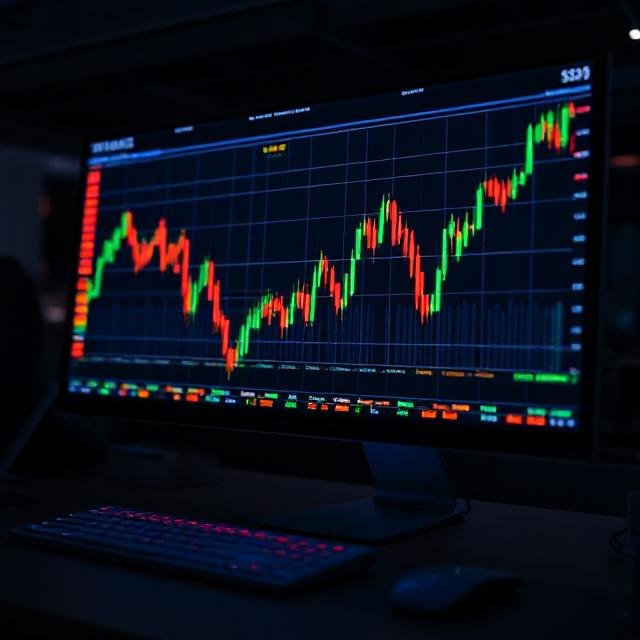If you’ve ever traveled internationally, you’ve participated in forex trading without even realizing it. Forex, or foreign exchange trading, is the process of exchanging one currency for another. While individuals might do this for travel, the forex market itself is a massive, decentralized global marketplace where currencies are traded 24 hours a day. It is the largest financial market in the world, with an estimated daily trading volume exceeding $6 trillion. Calculator

Understanding Forex Trading
Forex trading involves buying one currency while simultaneously selling another. Currencies are quoted in pairs, such as EUR/USD (Euro/US Dollar) or USD/JPY (US Dollar/Japanese Yen). The first currency in the pair is called the base currency, and the second is the quote currency.
For example, if the EUR/USD pair is quoted at 1.1000, it means 1 Euro is worth 1.10 US Dollars. If you believe the Euro will strengthen against the Dollar, you would buy EUR/USD. Conversely, if you think the Euro will weaken, you would sell EUR/USD.
How the Forex Market Works
Unlike stock markets, which are centralized, the forex market operates over-the-counter (OTC). This means that transactions occur directly between parties, usually through electronic trading networks or by phone.
The forex market is divided into three main sessions:
- Asian Session
- European Session
- North American Session
This ensures that the market is open 24 hours a day, five days a week.
Who Participates in Forex Trading?
- Banks: Major global banks facilitate most of the trading volume.
- Central Banks: These institutions manage national currency stability.
- Corporations: Businesses engage in forex to hedge against currency risks.
- Retail Traders: Individual investors participate through online forex brokers.
Benefits of Forex Trading
1. High Liquidity
The forex market is extremely liquid, meaning you can buy and sell currencies quickly with minimal price fluctuation.
2. 24-Hour Market
With round-the-clock trading, forex offers flexibility to trade at any time.
3. Leverage Opportunities
Forex brokers offer leverage, allowing traders to control larger positions with a smaller amount of capital.
4. Low Transaction Costs
Most forex brokers charge a small spread instead of a commission, keeping trading costs low.
Risks Involved in Forex Trading
1. High Volatility
While volatility creates trading opportunities, it can also lead to significant losses.
2. Leverage Risk
Leverage magnifies both gains and losses. Trading with high leverage can quickly deplete your capital.
3. Market Risk
Economic indicators, geopolitical events, and central bank policies can cause unexpected market movements.
Key Forex Trading Terminologies
- Pip: The smallest price move in a currency pair.
- Spread: The difference between the bid and ask price.
- Leverage: Borrowed capital to increase trading position size.
- Margin: The amount required to open a leveraged position.
- Lot: Standard trading size in forex, usually 100,000 units of the base currency.
How to Start Forex Trading
Step 1: Choose a Reliable Forex Broker
Look for a broker regulated by financial authorities such as the FCA, ASIC, or NFA.
Step 2: Open a Trading Account
Complete the broker’s application and verify your identity.
Step 3: Fund Your Account
Deposit funds using your preferred payment method.
Step 4: Choose a Trading Platform
Most brokers offer platforms like MetaTrader 4 (MT4) or MetaTrader 5 (MT5).
Step 5: Start Trading
Analyze the market, select your currency pairs, and execute your trades.
Forex Trading Strategies
1. Scalping
Focuses on making small profits from minute price changes.
2. Day Trading
Positions are opened and closed within the same trading day.
3. Swing Trading
Traders hold positions for several days to capitalize on market swings.
4. Position Trading
Long-term strategy based on fundamental analysis.
Fundamental vs. Technical Analysis
- Fundamental Analysis: Evaluates economic indicators like GDP, interest rates, and employment data.
- Technical Analysis: Uses historical price charts and indicators to predict future price movements.
Tips for Successful Forex Trading
- Educate Yourself: Take online courses and read forex trading books.
- Use a Demo Account: Practice trading with virtual money before risking real capital.
- Manage Risk: Use stop-loss orders and only risk a small percentage of your capital per trade.
- Stay Updated: Keep an eye on economic calendars and news events.
Advanced Tools and Indicators in Forex Trading
For traders looking to gain an edge, there are numerous advanced tools and indicators available.
- Moving Averages (MA): Help smooth out price data and identify trends over specific periods.
- Relative Strength Index (RSI): Measures the speed and change of price movements to identify overbought or oversold conditions.
- Bollinger Bands: Volatility bands placed above and below a moving average to detect market volatility.
- Fibonacci Retracement: Used to predict potential support and resistance levels.
Psychological Aspects of Forex Trading
Success in forex trading isn’t just about strategy and tools; psychology plays a crucial role. Emotions like fear, greed, and impatience can cloud judgment and lead to poor trading decisions. Developing discipline, patience, and a solid trading plan is essential for long-term success.
Managing Emotions
- Stick to Your Plan: Avoid impulsive trades that deviate from your strategy.
- Accept Losses: Understand that losses are part of trading and avoid revenge trading.
- Practice Mindfulness: Techniques like meditation can help maintain emotional balance.
Choosing the Right Currency Pairs
Not all currency pairs are created equal. Beginners are often advised to start with major pairs like EUR/USD, GBP/USD, and USD/JPY because they have the highest liquidity and lower spreads. Exotic pairs may offer higher profits but come with greater volatility and wider spreads.
Major Pairs
- EUR/USD
- USD/JPY
- GBP/USD
- USD/CHF
Minor Pairs
- EUR/GBP
- AUD/JPY
- GBP/JPY
Exotic Pairs
- USD/SEK
- USD/HKD
- USD/SGD
Building a Trading Plan
A well-structured trading plan is the foundation of successful forex trading. Your plan should include:
- Trading Goals: Define your financial objectives and risk tolerance.
- Strategy: Choose and backtest your trading strategies.
- Risk Management Rules: Set your stop-loss, take-profit levels, and maximum drawdown limits.
- Review and Improve: Regularly analyze your trades and adjust your plan as needed.

The Future of Forex Trading
With advancements in technology, forex trading is becoming more accessible and efficient. The rise of algorithmic trading and mobile trading apps are shaping the future of this dynamic market. Regulatory bodies are also implementing measures to ensure transparency and protect traders.
Additionally, artificial intelligence and machine learning are beginning to play a role in developing sophisticated trading algorithms. Blockchain technology may also revolutionize forex trading by enabling faster and more secure cross-border payments.
Conclusion
Forex trading offers numerous opportunities for profit, but it also comes with significant risks. By understanding how the market works and applying sound trading strategies, you can increase your chances of success. Whether you’re a beginner or an experienced trader, continuous learning and risk management are key to thriving in the forex market.
Ready to get started? Choose a regulated broker, practice on a demo account, and dive into the exciting world of forex trading today!


